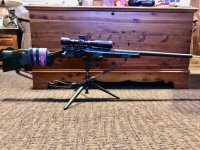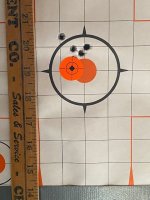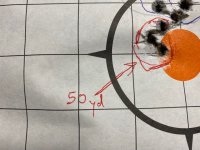In my experience, we always zeroed at 100 yards. The adjustments for zeroing were done with the hex wrench in the center of the turrets. The only thing that made it challenging was the lack of tactile increments when zeroing. Getting a perfect zero was challenging at times. At one point, some of us created a template that fit around the elevation turret that had graduations representing MOA of adjustment. Around the circumference of the template were graduated lines indicating MOAs of adjustment. With this template we would use the hex wrench, acting as pointer, to count off the graduations as we adjusted the zero. The spacing of the increments on the template was determined by trial and error. It took some time to finalize it, but it worked pretty good. I wish I still had one. And a Unertl to go with it, of course.
BDC was set for the 173gr FMJ M118 Special Ball load. Muzzle velocity was supposed to be 2550-2600 fps. If I remember correctly, the G1 BC was .453. The fine tune adjustment allowed for accounting for different velocities and environments. A revolutionary design for the time (late 1970s and early 1980s). I always marveled at how ingenious the design was.
When the M118LR came out, it needed to closely match the Unertl BDC along with some other requirements and scopes.
The parallax adjustment was an absolute mystery to most. First, there was not good comprehension of what parallax was, how it affected your aim (potentially) and how to adjust it out. Second, there were no indications on the adjustment what you were doing. It was all a mystery. The objective bell is where it was adjusted, after loosening the locking ring with the spanner wrench. Turning the adjustment ring out only moved the objective lens cell if the locking ring was in contact with the adjustment ring. If it was not, the objective cell moved when the locking ring was tightened (pulled the objective lens cell into the adjustment ring). The locking ring threaded into the objective lens cell. The adjustment ring was threaded to the scope's objective bell. It only really moved the cell on its own when it was turned in. When adjusting this way, the adjustment ring pushes the objective cell in and pulls the loosened locking ring along with it. When the correct adjustment is found, tightening the locking ring only screws the lock ring against the adjustment ring, locking the objective cell in place where the adjustment ring had stopped it.
With this in mind, what I found works best is the following:
- Loosen the objective locking ring and screw it out noticeably, maybe a 1/4". If it comes off, not problem, just screw it back in until the first two or three threads are engaged.
- Screw the objective adjustment ring out so that it meets the locking ring. If the scope body is painted, you will notice how far the adjustment ring has moved forward on the scope body.
- Grabbing the locking ring, pull it forward. It should move smoothly, but with some resistance, forward. There is an o-ring and lube that is holding a tight seal on the interior of the scope. If you look through the scope, it should now be noticeably out of focus.
- While looking at a target at the distance you want to be parallax-free, begin turning the adjustment ring in, pushing the objective cell into the scope. As you do this, the target image will get clearer.
- Just as you would focus any scope, as you adjust, continually check for the absence of parallax, not just a "clear" target image. Once you have no parallax, tighten the locking ring down and you're done.
- The key is: your final adjustment with the adjustment ring must always be turning it in while pushing the objective cell in. If not, when you tighten the locking ring, it will pull the objective cell out of focus once again.
Hope this long explanation was helpful for those who read the entire thing. Pictures would help, but I don't have a Unertl of my own.
Semper fi,
AG




